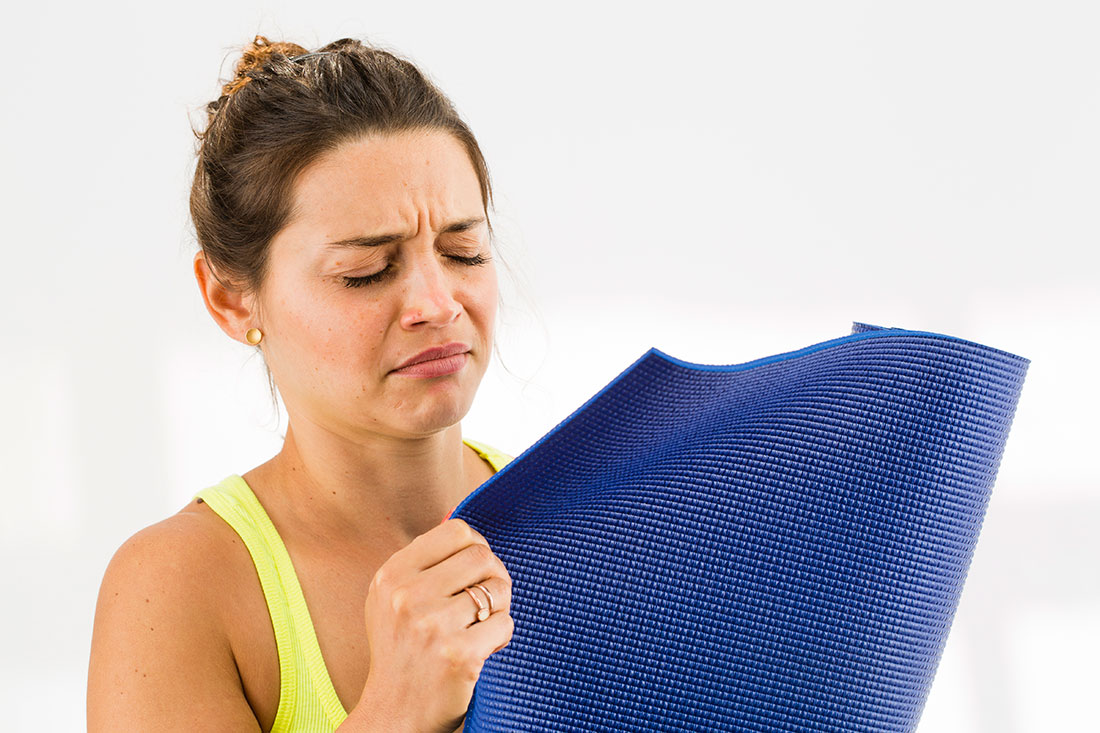Yoga is deemed as one of the fastest growing sports with over 24 million people practicing, and 44.4% of Americans interested in trying yoga. Yoga is a great way to rid your body of toxins, improve flexibility, increase mental focus, and reduce the physical effects of stress on the body.
The $27 billion industry, still has not been able to solve their biggest, most disturbing issue – your yoga mat is one of the filthiest surfaces imaginable. Why? According to the experts, it’s all because of the bacteria that gets transferred through direct skin contact.
Have you noticed an increase in your allergies? Or a red rash on your feet? Have you unexpectedly come down with the flu?
With yoga being the fastest growing sport the demand brings more classes, more people, and more germs. With yoga towels at $65 a pop, yoga mats costing up to $130, and yoga and gym memberships averaging $145 a month, the average yogi is buying a new mat and towel every few months because of bacteria causing odor and degradation. Why is such an expensive, popular sport grosser than a toilet seat?
1. Bacteria grows in warm moist environments – Your yoga class is the perfect breeding ground for germs. As a recent bacteria test at a studio in Houston discovered, the yoga teacher’s mat came back with a high yeast count, and a yogi mom’s mat tested positive for pantoea agglomerans, a coliform bacteria and fecal indicator. Whether you rent or own your own yoga mat, under a microscope you could find up to 12+ million counts of bacteria living on just one yoga mat. These infectious bacteria range from dust mites, parasites, to viruses. All of these bacteria’s potentially causing athlete’s foot, planters warts, staph, viral infections and allergy flare ups.
2. Yoga towels and mats with a microfiber top make it worse – Microfiber towels for the top of your mat might help stop you from slipping, but they do not prevent your sweat from absorbing through the towel and into your yoga mat. Yoga mats are porous and retain liquid creating a perfect colonization for odor, bacteria and fungi. Microfiber towels also keep sweat contained in one spot, creating a wet puddle environment for bacteria to colonize, just like a yoga mat. Using a yoga towel and mat ends up doubling your exposure risk.
3. You do not clean your mat – Time has become one of the most valuable things we own. Let’s be honest, most of us don’t clean our mats. It’s time consuming and you can’t just throw it into the washer and dryer. Even if you are a clean freak with your mat, you can guarantee the studio or gym you go to is not cleaning their floors or mats between classes. Some elite studios and gyms have even admitted that their mats are only washed every two months.
4. If you do clean your mat, you’re using wipes or essential oils to sanitize – Let’s think about this. A yoga mat is made of a very porous rubber. Bacteria seeps into the pores. A sanitizer wipe does not reach all the way into the mat, it is meant to surface clean. As Dr. Philip Tierno, the director of clinical microbiology at N.Y.U Medical Center and the author of the book “The Secret Life of Germs” confirms, wipes need to have alcohol, chlorine, or quat-based disinfectants to work. They also need to be moist enough to wet the entire surface. Essential oils might be the all-natural alternative to go, but without alcohol or bleach, just like wipes they only sparsely clean the top surface. This has also been proven in hospital environments, as Dr. Kelly Reynolds, points out “germs are invisible. A surface can look clean, while still housing a significant amount of pathogens. Also absorption rate of disinfectants or sanitizing wipes may not stay wet enough or dry before the contact time is achieved.”
5. Your half-naked body – Anybody who has been to a hot yoga class knows wearing less clothing keeps you cooler and more agile for movement. Your skin, your largest organ, is loaded with organisms and a lot of them come off when you sweat. Your mat touches a floor people have been sweating and walking on, you then place your face, hands, feet, forehead, and entire body on the mat. What’s worse is rolling up your yoga mat when it’s wet from sweat or after cleaning. Some people even throw it into the truck of their hot car! And, since we don’t clean our mats, we repeat this cycle all over again our next class. With the average person touching his or her face 18 times per hour, passing germs from the nose and mouth to the skin and back, what are you exposing yourself too during yoga class?
While we we’ve heard for years about how gross mats and studios are, the only solution has been to clean your mat with sanitizer wipes, which we have just explained doesn’t really work. Whether you practice once a week or every day, there is no way to fully prevent exposing yourself to this bacteria… until now.
So don’t start giving up on your “OMs” just yet yogis! There is a new solution. A cover for your yoga mat. Just like we have pillowcases, one of the newest start-ups in the industry, a company called Kosha, created covers for yoga mats and accessories.
Kosha Covers, invented by twin entrepreneur yogis, are simple. The cover fully encloses the mat, like a pillow case, eliminating the need to clean or buy a new yoga mat. A zipper around the perimeter allows ease the insertion and removal of the mat.
These covers aren’t made from your typical cotton or microfiber fabric. Kosha invented an anti-bacterial fabric specifically for yoga. The soft touch fabric is an innovative, eco-friendly, odor free, and anti-bacterial material that is unseen in any other product currently in the yoga market.
Two important differences between a Kosha cover and a yoga towel:
1. The innovative bamboo weave construction of the fabric’s surface quickly absorbs any moisture, and distributes it over a large surface area, accelerating the evaporation process. The fabric is 4x more absorbent than cotton, creates a quick dry surface, and is more durable and lightweight than other fabrics.
2. How does Kosha prevent the sweat from reaching your mat? Kosha adheres a water base hydrophobic membrane to the back of their fabric, which acts as a barrier between the surface of the cover and your yoga mat.
Sounds too good to be true? Kosha has the test results to back up their claims. Kosha fabric passes three of the exclusive AATCC standard tests. Kosha products are 99.9% effect against killing the microbes’ staph, k.pneumonia, and e.coli. Kosha fabric is resistant against mold, mildew, fungus, and does not fade or change shape after washing.
Afraid of slipping? Kosha took the covers a step further by designing the cover where the more you sweat, the more traction you have.
What about cleaning the cover? Kosha Covers can go into your washer and dryer daily and be ready for use the next day. Or wash it once a week with your towels as the website advises, since the antibacterial cover protects you until you’re ready to wash the cover.
At $85 a cover, Kosha even gives you a new yoga mat with your purchase, because they’re not going to have you put your old infected mat inside your new cover. If you want to “protect you and your mat” as Kosha’s slogan suggest, invest in a Kosha Cover. The covers are also versatile as some customers have used them as a cover for their child’s nap time mat and even a cover for their camping sleep pads – for any of you out there that our camping yogis.













